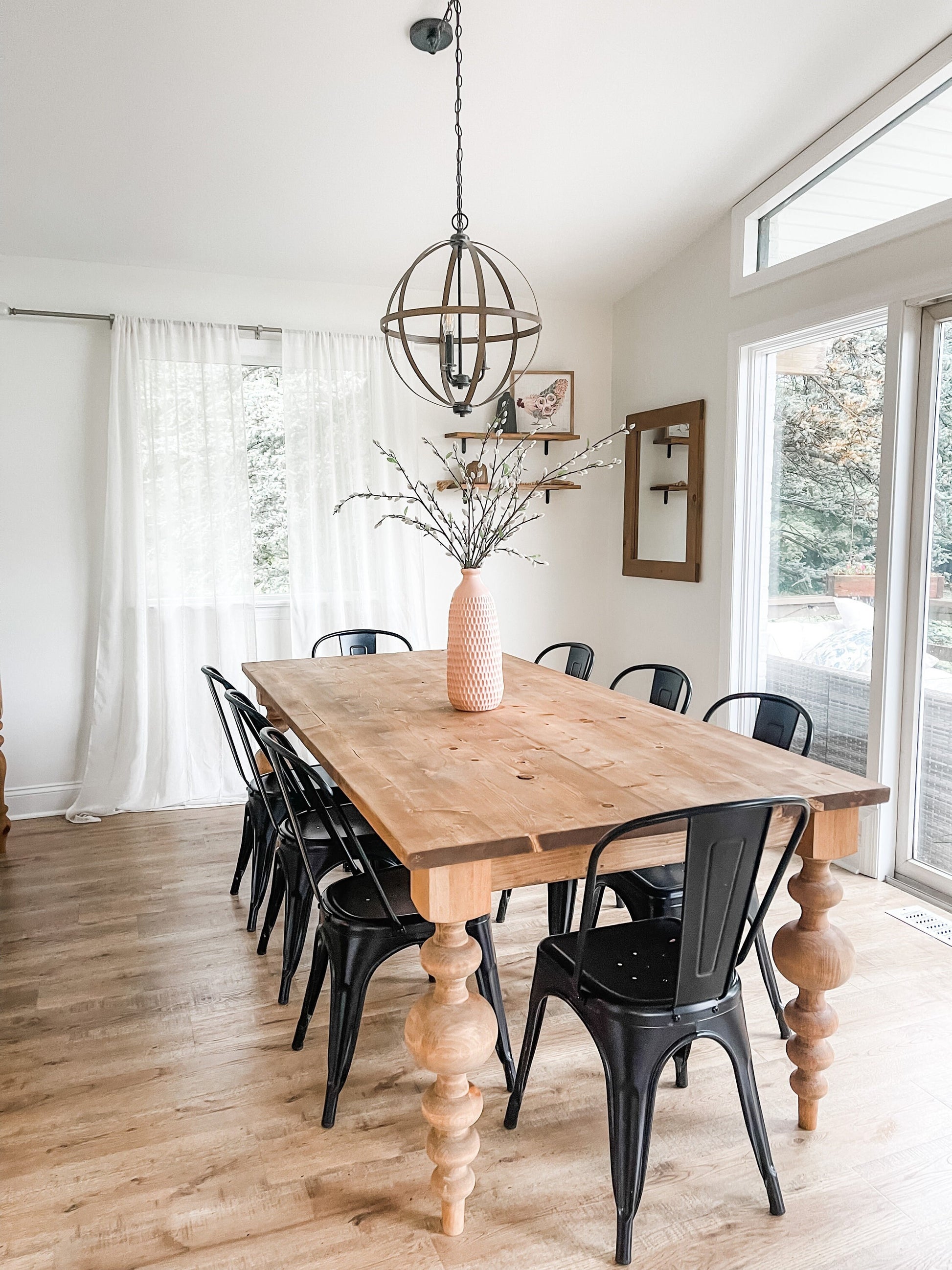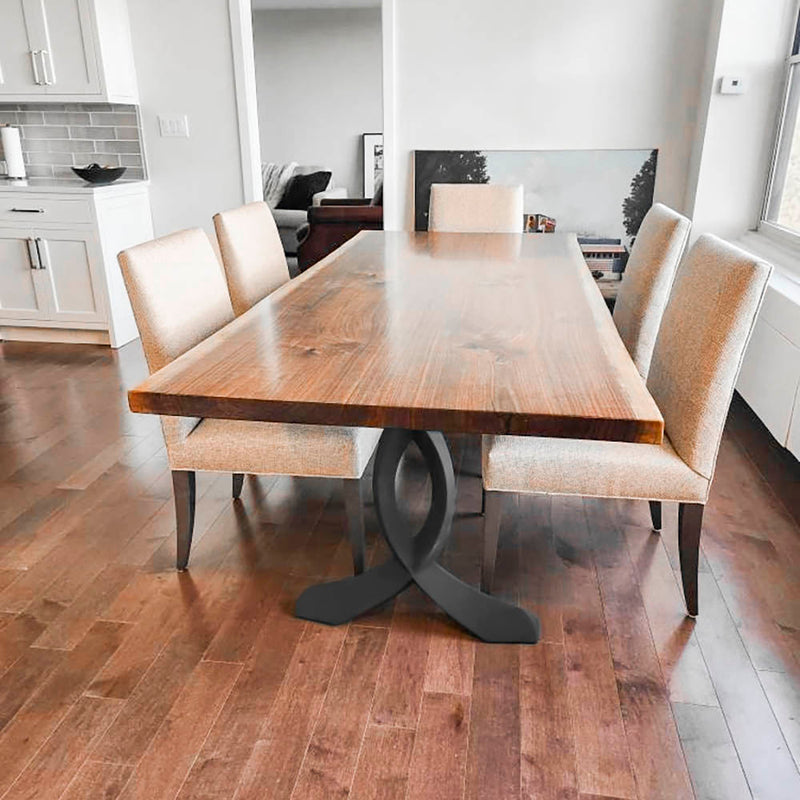The Impact of Dining Room Table Legs on Your Table's Overall Design
The Impact of Dining Room Table Legs on Your Table's Overall Design
Blog Article
Just How to Choose the Perfect Dining-room Table Legs for Your Home Design
Choosing the ideal dining room table legs is a nuanced procedure that calls for mindful factor to consider of different elements, including your room restraints, visual choices, and sensible requirements. The interplay between measurements, styles, and materials can dramatically affect the atmosphere of your dining location, making it essential to approach this decision carefully.
Assess Your Dining Area
Examining your dining room is essential for selecting the right table legs that complement both visual appeals and functionality. Begin by gauging the measurements of your dining area, consisting of ceiling height, floor room, and closeness to various other furniture. This information will aid identify the proper dimension and height of your eating table, which straight influences the choice of table legs.
Following, take into consideration the style and design of your dining room. An open-concept style might profit from table legs that offer visual agility, such as slender metal or acrylic options. On the other hand, a much more standard setting might ask for sturdy wood legs that give a sense of durability.
Evaluate the existing color combination and products in your dining location. Integrating the table legs with these components produces a natural appearance that boosts the overall style.
Inevitably, an extensive evaluation of your dining room will certainly assist you in making a notified decision, making certain that your table legs not only improve the aesthetic appeal yet also serve functional objectives.
Consider Your Design Preferences
When picking dining room table legs, it is essential to assess your personal style preferences, as they substantially influence the overall aesthetic of your dining room. Your choice of table legs can either complement or comparison with existing decoration, making it important to straighten them with your recommended interior decoration motif.
If your home leans towards a modern-day aesthetic, consider smooth metal or minimal wood legs that offer a tidy, uncluttered appearance. For a more conventional approach, ornate wooden legs with detailed carvings can add a touch of style and sophistication. Industrial styles gain from robust, resources such as reclaimed wood and steel mixes, showing a tough appeal.
Furthermore, farmhouse and rustic styles typically prefer sturdy, beefy legs that stimulate a feeling of heat and convenience. Conversely, if your decor is diverse, you may choose unusual forms or a mix of materials to develop aesthetic rate of interest.

Evaluate Product Options
The choice of material for dining area table legs plays a crucial role in both durability and visual allure. Common products include timber, metal, and composite options, each offering distinctive features that can influence the general appearance and longevity of your table.
Timber is a timeless choice, understood for its warmth and flexibility. Hardwoods like oak and walnut supply outstanding stamina and can be ended up in numerous spots to match any type of style. Nevertheless, softwoods like pine are a lot more susceptible to damages and scratches, making them less excellent for high-traffic locations.
Metal legs, commonly crafted from steel or light weight aluminum, show modernity and industrial beauty. They are highly durable and immune to wear, making them suitable for family members with children or constant events (dining room table legs). Furthermore, metal can be completed in numerous shades, improving the modification opportunities
Composite products, such as MDF or laminate, offer affordability and varied designs. While usually much less durable than solid timber or steel, they can still supply a fashionable look and are typically easy to preserve.
Ultimately, the product you pick ought to align with your way of living, visual Look At This preferences, and the degree of use your eating table will certainly experience.
Determine Elevation and Size
Picking the proper elevation and size for your dining-room table is necessary for both capability and convenience. The standard elevation for dining tables normally ranges from 28 to 30 inches, enabling ample legroom for many individuals when seated. Nonetheless, it is essential to consider the dimensions of your eating room and the kinds of chairs you intend to make use of.

Additionally, think about the percentages of your dining area. A larger table in a large location can develop a grand ambiance, while a smaller table works well in even more intimate settings. Eventually, the ideal elevation and size will harmonize with your overall design and boost the eating experience for you and your guests.
Explore Modification Possibilities

In addition, the style of the legs can be tailored to fit various designs, such as rustic, modern, or commercial. For instance, conical legs can stimulate a mid-century contemporary feeling, while beefy, block-style legs might reverberate with typical or farmhouse decoration.
House owners can additionally discover color surfaces, from all-natural timber stains to paint, enabling them to match or contrast with Check This Out the tabletop and surrounding style.
Moreover, leg height can be adapted to suit particular seating setups or individual preferences, improving both convenience and capability.
Finally, distinct embellishments, such as makings or attractive braces, can additionally individualize the table legs, making the eating experience not simply a meal but a declaration piece in the home. By taking into consideration these personalization choices, house owners can develop an eating space table that really reflects their uniqueness.
Final Thought
Picking the ideal dining-room table legs requires careful factor to consider of various aspects, consisting of the dimensions of the dining area, style preferences, material sturdiness, and wanted height. Personalization choices even more improve the capacity to accomplish a cohesive visual that matches the total style. By methodically reviewing these aspects, house owners can guarantee that the selected table legs not just fulfill useful needs however additionally add favorably to the eating experience and atmosphere of the home.
Choosing the optimal dining room table legs is a nuanced procedure that calls for careful factor to consider of different components, including your space restrictions, aesthetic preferences, and functional requirements.Assessing your eating area is critical for choosing the right table legs that enhance both aesthetics and visit this web-site functionality.When identifying dimension, measure the location where the table will certainly be placed to ensure it fits conveniently, permitting for at least 36 inches of clearance around the table for easy movement. A bigger table in a roomy location can develop a grand setting, while a smaller table works well in even more intimate settings.Choosing the suitable dining room table legs needs careful factor to consider of numerous factors, consisting of the dimensions of the dining area, design preferences, material sturdiness, and desired elevation.
Report this page